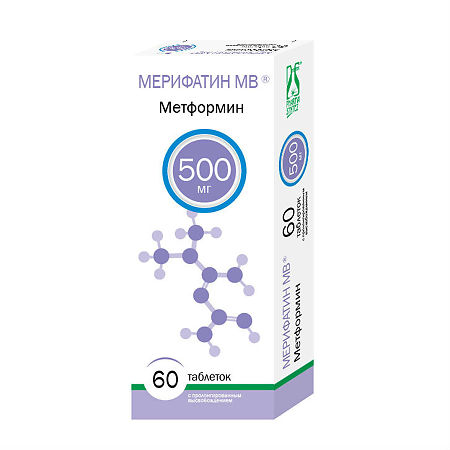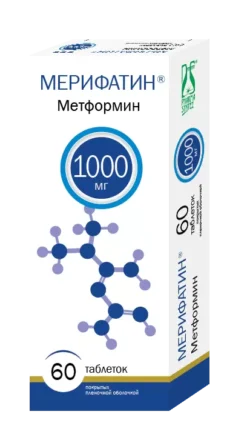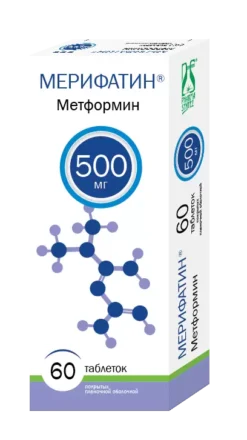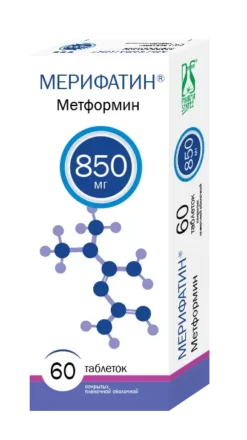No products in the cart.
Merifatin MB, 500 mg 60 pcs
€1.00
Out of stock
(E-mail when Stock is available)
Description Pharmacokinetics:
Metformin is a biguanide with hypoglycemic action that reduces both basal and postprandial plasma glucose concentrations. It does not stimulate insulin secretion and therefore does not cause hypoglycemia. Increases the sensitivity of peripheral receptors to insulin and glucose utilization by cells. Reduces glucose production by the liver by inhibiting gluconeogenesis and glycogenolysis. Delays absorption of glucose in the intestine.
Metformin stimulates glycogen synthesis by acting on glycogen synthase. It increases the transport capacity of all types of membrane glucose transporters.
Absorption
After a single administration of sustained-release metformin (500 mg and 750 mg sustained-release tablets) at a dose of 1500 mg, the mean time to reach the maximum plasma concentration of metformin (Tcmax) is 5 h (range 4-12 h). After a single administration of 1 sustained-release metformin tablet in a dose of 1000 mg after a meal, the average Tcmax is 5 h (range 4-10 h).
In an equilibrium state identical to the equilibrium state of metformin with normal release, the maximum concentration (Cmax) and area under the concentration-time curve (AUC) increase not in proportion to the dose taken. AUC after a single dose of sustained-release metformin in a dose of 2000 mg is similar to that observed after administration of metformin with normal release in a dose of 1000 mg twice daily.
Interindividual variability of Cmax and AUC after administration of metformin in the form of sustained release tablets is similar to that observed after administration of normal-release metformin.
After a single dose of sustained-release metformin in a dose of 1000 mg after a meal, AUC is increased by 77%, Cmax is increased by 26% and TCmax is increased by approximately 1 hour. Absorption of sustained-release metformin does not vary with food intake.
There is no cumulation with repeated administration of sustained-release metformin in doses up to 2000 mg.
Distribution
Metformin is rapidly distributed in tissues, almost does not bind to plasma proteins and is able to accumulate in erythrocytes. Cmax in blood is lower than Cmax in plasma and is reached in approximately the same time. The average volume of distribution is 63-276 liters.
Metabolism
It is metabolized to a very low degree; no metabolites have been detected in the body.
Elimination
Extracted by the kidneys unchanged. Clearance of metformin in healthy volunteers is more than 400 ml/min (4 times higher than creatinine clearance), indicating the presence of active tubular secretion.
The elimination half-life is approximately 6.5 h.
Renal dysfunction
In impaired renal function, metformin clearance decreases in proportion to creatinine clearance (CK), respectively, the elimination half-life increases, the plasma concentration of metformin increases, and the risk of cumulation increases.
.
Indications
Indications
Type 2 diabetes mellitus in adults (especially in obese patients) with ineffective diet therapy and exercise:
as monotherapy;
in combination with other oral hypoglycemic agents or insulin.
Pharmacological effect
Pharmacological effect
Metformin is a biguanide with a hypoglycemic effect, reducing both basal and postprandial plasma glucose concentrations. It does not stimulate insulin secretion and therefore does not cause hypoglycemia. Increases the sensitivity of peripheral receptors to insulin and the utilization of glucose by cells. Reduces liver glucose production by inhibiting gluconeogenesis and glycogenolysis. Delays the absorption of glucose in the intestines.
Metformin stimulates glycogen synthesis by acting on glycogen synthase. Increases the transport capacity of all types of membrane glucose transporters.
While taking metformin, the patient’s body weight either remains stable or decreases moderately. Metformin has a beneficial effect on lipid metabolism: it reduces the content of total cholesterol, LDL (low-density lipoproteins) and triglycerides.
Pharmacokinetics:
Absorption
After a single dose of extended-release metformin (500 mg and 750 mg extended-release tablets) at a dose of 1500 mg, the average time to reach maximum metformin plasma concentration (Tmax) is 5 hours (range 4-12 hours). After a single dose of 1 tablet of metformin extended release at a dosage of 1000 mg after a meal, the average Tmax is 5 hours (range 4-10 hours).
At steady state, identical to that of regular-release metformin, the maximum concentration (Cmax) and area under the concentration-time curve (AUC) increase disproportionately to the dose taken. The AUC following a single dose of 2000 mg extended-release metformin is similar to that observed after regular-release metformin 1000 mg twice daily.
Intra-individual variability in Cmax and AUC following administration of metformin extended-release tablets is similar to that observed after administration of regular-release metformin.
After a single dose of 1000 mg extended-release metformin after a meal, AUC increases by 77%, Cmax increases by 26% and TCmax increases by approximately 1 hour. The absorption of extended-release metformin does not change depending on the composition of the meal.
No accumulation is observed with repeated doses of extended-release metformin at doses up to 2000 mg.
Distribution
Metformin is quickly distributed into tissues, practically does not bind to plasma proteins and is able to accumulate in red blood cells. Cmax in the blood is lower than Cmax in the blood plasma and is achieved in approximately the same time. The average volume of distribution is 63-276 l.
Metabolism
It is metabolized to a very weak extent; no metabolites were found in the body.
Removal
It is excreted unchanged by the kidneys. Metformin clearance in healthy volunteers is more than 400 ml/min (4 times more than creatinine clearance), indicating the presence of active tubular secretion.
The half-life is approximately 6.5 hours.
Renal dysfunction
If renal function is impaired, the clearance of metformin decreases in proportion to the clearance of creatinine (CC); accordingly, the half-life increases, the concentration of metformin in the blood plasma increases, and the risk of its accumulation increases.
Special instructions
Special instructions
Lactic acidosis
Lactic acidosis is a rare but serious (high mortality unless promptly treated) complication that may occur due to accumulation of metformin. Cases of lactic acidosis when taking metformin occurred mainly in patients with diabetes mellitus with severe renal failure.
Other associated risk factors should be taken into account, such as decompensated diabetes mellitus, ketosis, prolonged fasting, alcoholism, liver failure and any condition associated with severe hypoxia, severe infectious disease and concomitant use with certain medications. This may help reduce the incidence of lactic acidosis.
The risk of developing lactic acidosis should be taken into account when nonspecific signs appear, such as muscle cramps accompanied by dyspeptic disorders, abdominal pain, and severe asthenia.
Lactic acidosis is characterized by severe malaise with general weakness, acidotic shortness of breath and vomiting, abdominal pain, muscle cramps and hypothermia followed by coma. Diagnostic laboratory parameters are a decrease in blood pH (less than 7.35), plasma lactate concentration over 5 mmol/l, increased anion gap and lactate/pyruvate ratio. If lactic acidosis is suspected, stop taking the drug and consult a doctor immediately.
Intravascular administration of iodinated radiocontrast agents can lead to the development of renal failure and accumulation of metformin, which increases the risk of developing lactic acidosis. Metformin should be discontinued, depending on renal function, 48 hours before or during an X-ray examination using iodinated contrast agents, and not resumed until 48 hours after it, provided that during the examination, renal function was found to be normal.
Surgical operations
The use of metformin should be discontinued 48 hours before elective surgery and can be continued no earlier than 48 hours after, provided that renal function has been found to be normal during the examination.
Kidney function
Since metformin is excreted by the kidneys, before starting treatment and regularly thereafter, it is necessary to determine the content and/or creatinine clearance in serum: at least once a year in patients with normal renal function and 2-4 times a year in elderly patients, as well as in patients with creatinine clearance at the lower limit of normal.
Particular caution should be exercised in case of possible impairment of renal function in elderly patients, with simultaneous use of antihypertensive drugs, diuretics or non-steroidal anti-inflammatory drugs.
For dehydration (chronic or severe diarrhea, repeated bouts of vomiting).
Heart failure
Patients with heart failure have a higher risk of developing hypoxia and renal failure. Patients with chronic heart failure should have their cardiac renal function monitored regularly while taking metformin. Taking metformin in acute heart failure and chronic heart failure with unstable hemodynamic parameters is contraindicated.
Other Precautions
– Patients are advised to continue to follow a diet with even carbohydrate intake throughout the day. Overweight patients are advised to continue to follow a hypocaloric diet (but not less than 1000 kcal/day). Patients should also exercise regularly.
– Patients should inform their doctor about any treatment they are undergoing and any infectious diseases such as colds, respiratory infections or urinary tract infections.
– Regular routine laboratory tests are recommended to monitor diabetes mellitus.
– Metformin does not cause hypoglycemia when used alone, but caution is recommended when using it in combination with insulin or other oral hypoglycemic agents (for example, sulfonylurea derivatives or repaglinide, etc.). Symptoms of hypoglycemia include weakness, headache, dizziness, increased sweating, rapid heartbeat, blurred vision, or difficulty concentrating.
– It is necessary to warn the patient that the excipients of the drug Merifatin MB can be excreted unchanged through the intestines, which does not affect the pharmacological effect of the drug.
Impact on the ability to drive vehicles. Wed and fur.:
Monotherapy with Merifatin MB does not cause hypoglycemia, and therefore does not affect the ability to drive vehicles and machines. However, it is possible to develop hypoglycemia when using metformin in combination with other hypoglycemic drugs (sulfonylurea derivatives, insulin, repaglinide, etc.). If symptoms of hypoglycemia appear, you should not drive vehicles or machinery.
Active ingredient
Active ingredient
Metformin
Composition
Composition
For one tablet:
Active ingredient: metformin hydrochloride – 500 mg.
Excipients: hypromellose 2208 – 256.0 mg; carmellose sodium (sodium carboxymethylcellulose) – 28.0 mg; hyprolose (hydroxypropylcellulose) – 10.0 mg; copovidone – 2.0 mg; magnesium stearate – 4.0 mg.
Contraindications
Contraindications
– Hypersensitivity to metformin or to any excipient;
– diabetic ketoacidosis, diabetic precoma, coma;
– renal failure or impaired renal function (creatinine clearance less than 30 ml/min);
– acute conditions with a risk of developing renal dysfunction: dehydration (with chronic or severe diarrhea, repeated bouts of vomiting), severe infectious diseases (for example, respiratory tract infections, urinary tract infections), shock;
– clinically pronounced manifestations of acute or chronic diseases that can lead to the development of tissue hypoxia (including acute heart failure, chronic heart failure with unstable hemodynamic parameters, respiratory failure, acute myocardial infarction);
– extensive surgical operations and injuries, when insulin therapy is indicated (see “Special Instructions”);
– liver failure, liver dysfunction;
– chronic alcoholism, acute alcohol intoxication;
– pregnancy;
– lactic acidosis (including history);
– use within less than 48 hours before and within 48 hours after radioisotope or x-ray studies with the introduction of an iodine-containing contrast agent (for example, intravenous urography, angiography) (see “Interaction with other drugs”);
– adherence to a hypocaloric diet (< 1000 cal/day);
– age under 18 years (due to the lack of data on the effectiveness and safety of use in this age group).
With caution:
– In patients over 60 years of age who perform heavy physical work, which is associated with an increased risk of developing lactic acidosis;
– in patients with renal failure (creatinine clearance 30-59 ml/min);
– during breastfeeding.
Side Effects
Side Effects
Classification of the incidence of HP when using the drug according to the recommendations of the World Health Organization (WHO): very often (≥1/10); often (≥ 1/100, < 1/10); uncommon (≥1/1000, <1/100); rare (≥1/10000, <1/1000); very rare (< 1/10000).
Metabolism: very rarely – lactic acidosis.
With long-term use of metformin, a decrease in the absorption of vitamin B12 may be observed. When megaloblastic anemia is detected, the possibility of such an etiology must be taken into account.
From the nervous system: often – taste disturbance (metallic taste in the mouth).
From the gastrointestinal tract: very often – nausea, vomiting, diarrhea, abdominal pain and lack of appetite. Most often they occur during the initial period of treatment and in most cases resolve spontaneously. To prevent symptoms, it is recommended to take metformin during or after meals. Slowly increasing the dose may improve gastrointestinal tolerability.
From the liver and biliary tract: very rarely – impaired liver function tests and hepatitis; after discontinuation of the drug, these HP completely disappear.
From the skin and subcutaneous tissues: very rarely – skin reactions such as erythema (redness of the skin), itching, urticaria.
If any of the HP indicated in the instructions worsen or other HP not listed in the instructions appear, you must inform your doctor.
Interaction
Interaction
Contraindicated combinations
Iodine-containing radiocontrast agents: against the background of functional renal failure in patients with diabetes mellitus, radiological examination using iodine-containing X-ray contrast agents can cause the development of lactic acidosis. Metformin should be discontinued depending on renal function 48 hours before or during an X-ray examination using iodinated contrast agents and resumed no earlier than 48 hours after, provided that renal function was found to be normal during the examination.
Combinations not recommended
Alcohol: with acute alcohol intoxication, the risk of developing lactic acidosis increases, especially in the case of:
– insufficient nutrition, adherence to a low-calorie diet;
– liver failure.
During drug therapy, you should avoid drinking alcohol and taking medications containing ethanol.
Combinations requiring caution
Medicines with an indirect hyperglycemic effect (for example, corticosteroids (systemic and local action) and tetracosactide, β2-adrenergic agonists, danazol, chlorpromazine when taken in large doses (100 mg per day) and diuretics: more frequent monitoring of blood glucose concentrations may be required, especially at the beginning of treatment. If necessary, the dose of Merifatin MB can be adjusted during treatment and after its cessation, based on from the glycemic level.
Diuretics: Concomitant use of loop diuretics may lead to the development of lactic acidosis due to possible functional renal failure.
When using the drug Merifatin MB simultaneously with sulfonylurea derivatives, insulin, acarbose, and salicylates, hypoglycemia may develop.
Nifedipine increases the absorption and Cmax of metformin.
Cationic drugs (amiloride, digoxin, morphine, procainamide, quinidine, quinine, ranitidine, triamterene, trimethoprim and vancomycin) secreted in the renal tubules compete with metformin for tubular transport systems and may lead to an increase in its Cmax.
Colesevelam, when used simultaneously with metformin in the form of extended-release tablets, increases the concentration of metformin in the blood plasma (increases AUC without a significant increase in Cmax).
Oral contraceptives, epinephrine, glucagon, thyroid hormones, phenothiazine derivatives, nicotinic acid
The hypoglycemic effect of metformin can be reduced by phenothiazides, glucagon, estrogens, oral contraceptives, phenytoin, sympathomimetics, nicotinic acid, isoniazid, slow calcium channel blockers, levothyroxine sodium.
Concomitant use with cimetidine reduces the rate of elimination of metformin, which can lead to the development of lactic acidosis.
In healthy volunteers, with simultaneous use of metformin and propranolol, as well as with the use of metformin and ibuprofen, no changes in their pharmacokinetic parameters were observed.
Metformin may reduce the effect of indirect anticoagulants.
Organic cation transporter substrates 1 and 2 (OST1 and OST2)
Metformin is a substrate of the organic cations OCT1 and OCT2.
When used together with metformin:
OCT1 inhibitors (such as verapamil) may reduce the hypoglycemic effect of metformin;
OCT1 inducers (such as rifampicin) may increase the absorption of metformin in the gastrointestinal tract and enhance its hypoglycemic effect;
OCT2 inhibitors (such as cimetidine, dolutegravir, ranolazine, trimethoprim, vandetanib, isavuconazole) may reduce the renal excretion of metformin and lead to an increase in its plasma concentration;
OCT1 and OCT2 inhibitors (such as crizotinib, olaparib) may reduce the hypoglycemic effect of metformin.
Overdose
Overdose
When using metformin in doses up to 85 g (42.5 times the maximum daily dose), no episodes of hypoglycemia were observed. However, in this case, the development of lactic acidosis was observed. Significant overdose or associated risk factors can lead to the development of lactic acidosis.
Symptoms of lactic acidosis are: severe weakness, myalgia, abdominal pain, respiratory disorders, increased drowsiness. In severe lactic acidosis, the development of arterial hypotension and resistant bradyarrhythmia was noted.
Treatment: if signs of lactic acidosis appear, the drug should be stopped immediately, the patient should be urgently hospitalized and, after determining the lactate concentration, the diagnosis should be clarified. The most effective measure for removing lactate and metformin from the body is hemodialysis. Symptomatic treatment is also carried out.
Storage conditions
Storage conditions
Store in a place protected from light, at a temperature not exceeding 25°C.
Keep out of the reach of children.
Shelf life
Shelf life
3 years.
Do not use after expiration date.
Manufacturer
Manufacturer
Farmasintez-Tyumen, Russia
Additional information
| Shelf life | 3 years. Do not use after the expiration date. |
|---|---|
| Conditions of storage | Store in the dark place at a temperature not exceeding 25°C. Store out of the reach of children. |
| Manufacturer | Pharmasintez-Tyumen, Russia |
| Medication form | controlled release tablets |
| Brand | Pharmasintez-Tyumen |
Other forms…
Related products
Buy Merifatin MB, 500 mg 60 pcs with delivery to USA, UK, Europe and over 120 other countries.
















